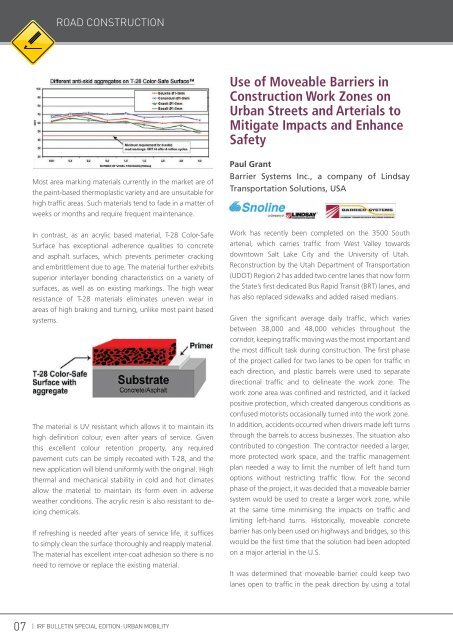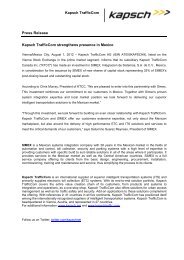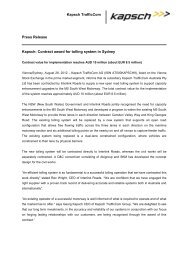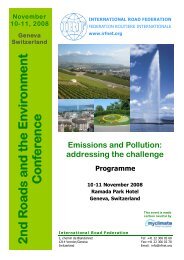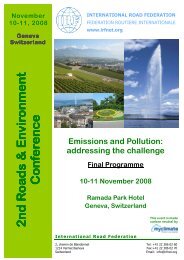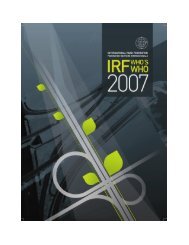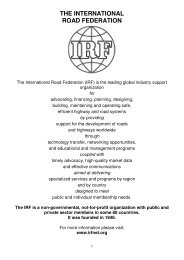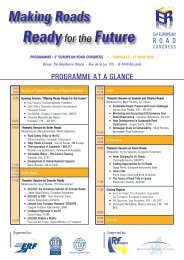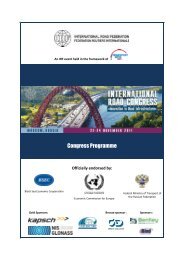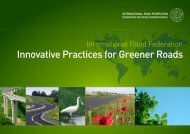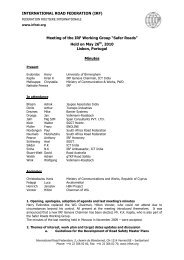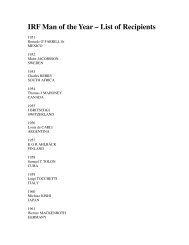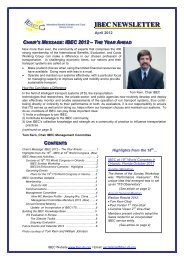Motorways and Urban Mobility - International Road Federation
Motorways and Urban Mobility - International Road Federation
Motorways and Urban Mobility - International Road Federation
You also want an ePaper? Increase the reach of your titles
YUMPU automatically turns print PDFs into web optimized ePapers that Google loves.
07<br />
ROAD CONSTRUCTION<br />
Most area marking materials currently in the market are of<br />
the paint-based thermoplastic variety <strong>and</strong> are unsuitable for<br />
high traffic areas. Such materials tend to fade in a matter of<br />
weeks or months <strong>and</strong> require frequent maintenance.<br />
In contrast, as an acrylic based material, T-28 Color-Safe<br />
Surface has exceptional adherence qualities to concrete<br />
<strong>and</strong> asphalt surfaces, which prevents perimeter cracking<br />
<strong>and</strong> embrittlement due to age. The material further exhibits<br />
superior interlayer bonding characteristics on a variety of<br />
surfaces, as well as on existing markings. The high wear<br />
resistance of T-28 materials eliminates uneven wear in<br />
areas of high braking <strong>and</strong> turning, unlike most paint based<br />
systems.<br />
The material is UV resistant which allows it to maintain its<br />
high definition colour, even after years of service. Given<br />
this excellent colour retention property, any required<br />
pavement cuts can be simply recoated with T-28, <strong>and</strong> the<br />
new application will blend uniformly with the original. High<br />
thermal <strong>and</strong> mechanical stability in cold <strong>and</strong> hot climates<br />
allow the material to maintain its form even in adverse<br />
weather conditions. The acrylic resin is also resistant to deicing<br />
chemicals.<br />
If refreshing is needed after years of service life, it suffices<br />
to simply clean the surface thoroughly <strong>and</strong> reapply material.<br />
The material has excellent inter-coat adhesion so there is no<br />
need to remove or replace the existing material.<br />
| IRF BULLETIN SPECIAL EDITION: URBAN MOBILITY<br />
Use of Moveable Barriers in<br />
Construction Work Zones on<br />
<strong>Urban</strong> Streets <strong>and</strong> Arterials to<br />
Mitigate Impacts <strong>and</strong> Enhance<br />
Safety<br />
Paul Grant<br />
Barrier Systems Inc., a company of Lindsay<br />
Transportation Solutions, USA<br />
Work has recently been completed on the 3500 South<br />
arterial, which carries traffic from West Valley towards<br />
downtown Salt Lake City <strong>and</strong> the University of Utah.<br />
Reconstruction by the Utah Department of Transportation<br />
(UDOT) Region 2 has added two centre lanes that now form<br />
the State’s first dedicated Bus Rapid Transit (BRT) lanes, <strong>and</strong><br />
has also replaced sidewalks <strong>and</strong> added raised medians.<br />
Given the significant average daily traffic, which varies<br />
between 38,000 <strong>and</strong> 48,000 vehicles throughout the<br />
corridor, keeping traffic moving was the most important <strong>and</strong><br />
the most difficult task during construction. The first phase<br />
of the project called for two lanes to be open for traffic in<br />
each direction, <strong>and</strong> plastic barrels were used to separate<br />
directional traffic <strong>and</strong> to delineate the work zone. The<br />
work zone area was confined <strong>and</strong> restricted, <strong>and</strong> it lacked<br />
positive protection, which created dangerous conditions as<br />
confused motorists occasionally turned into the work zone.<br />
In addition, accidents occurred when drivers made left turns<br />
through the barrels to access businesses. The situation also<br />
contributed to congestion. The contractor needed a larger,<br />
more protected work space, <strong>and</strong> the traffic management<br />
plan needed a way to limit the number of left h<strong>and</strong> turn<br />
options without restricting traffic flow. For the second<br />
phase of the project, it was decided that a moveable barrier<br />
system would be used to create a larger work zone, while<br />
at the same time minimising the impacts on traffic <strong>and</strong><br />
limiting left-h<strong>and</strong> turns. Historically, moveable concrete<br />
barrier has only been used on highways <strong>and</strong> bridges, so this<br />
would be the first time that the solution had been adopted<br />
on a major arterial in the U.S.<br />
It was determined that moveable barrier could keep two<br />
lanes open to traffic in the peak direction by using a total


